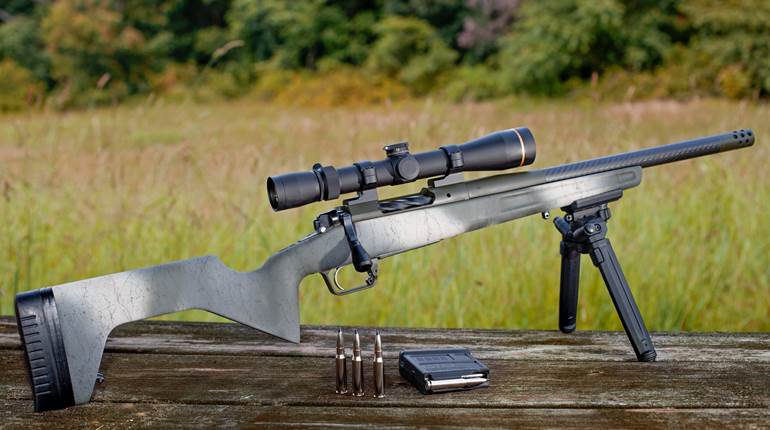
3/18/2013
The “Mossberg” name is most often associated with field-proven value-priced shotguns; however, the company also offers an equally diverse lineup of economical center-fire rifles, some of which are built on the respected ATR action. The Night Train, evaluated here, is one such variant.
Introduced in 2004, the ATR (All-Terrain Rifle) is essentially a no-frills workhorse; given the qualities demanded from a “tactical” rifle, there’s little wonder that the company selected it to serve as the basis for the Night Train. The ATR’s design is well-suited to be manufactured economically, thus the savings are passed on to the consumer. The suggested retail price of the Night Train II is $873; however, actual prices encountered at the retail level were substantially lower.
Machining a rifle’s receiver from round steel stock rather than a block reduces build time, and thus cost; but doing so prevents the recoil lug from being machined integrally, so it must be a separate component. Like similar rifles, the lug, which measures 0.185-inches-thick, is held in-place against the receiver’s front by the barrel locking nut. The receiver is drilled and tapped for scope bases.
As for the bolt, it’s of the traditional two-lug design, thereby resulting in a 90-degree throw. The bolt head itself is a separate piece, and unlike the glass-smooth bolt body, the sample rifle’s showed considerable tool marks. Extraction is by way of a sliding-plate extractor, while a plunger-type ejector sends cases well clear of the rifle. To enhance purchase, the rearward-sweeping bolt handle has checkering on the top and bottom portions of the knob. Interestingly, the bolt shroud has a projection that prevents the bolt-release button—located on the left rear portion of the receiver—from being unintentionally depressed, which is a well-though-out feature.
The Night Train features Mossberg’s relatively new Lightning Bolt-Action (LBA) trigger, which is user-adjustable. The test rifle’s broke cleanly at 3 pounds, 7 ounces. The trigger’s articulating blade, which projects from the shoe, prevents the rifle from firing unless the two are retracted in unison. The rifle’s two-position safety enables cycling of the bolt for unloading when in the rear or “safe” position. A red plastic insert in the polymer stock is revealed when the safety lever is in the forward, “fire” position.
For a “tactical” rifle, the Night Train’s barrel is relatively lightweight; in fact, the sporter-contour barrel measures 1.175 inches immediately ahead of the locking nut, and it tapers to 0.660 inches before “belling” to the threaded portion. The muzzle brake, which is of the “fish-gill” style, extends the barrel by 2 inches, resulting in an overall length of 22 inchces. The four-port, 3.770-inch-long brake seems like a bit much for a .308 Win.-chambered rifle, but there’s little doubt that it helps attenuate recoil, as well as makes the rifle more visually appealing. Although there are six longitudinal flutes approaching half the barrel’s overall length, they’re more cosmetic than functional.
The Night Train’s black synthetic stock has molded-in checkering in the fore-end and pistol grip areas and is fitted with a very soft recoil pad. Interestingly, the stock has two sling swivel attachment points on the fore-end—one molded integrally, one a separate stud—and a corresponding integral one on the butt. The separate sling swivel stud on the test rifle served as the attachment point for the included Caldwell bipod, while the other allowed for the use of the provided sling without being affixed directly to the bipod.
The Night Train comes with a pre-mounted Barska 6-24X 60 mm riflescope; but, due to the scope’s oversize objective lens, the company had to improvise. Because the scope has to be mounted extra-high to prevent contact with the barrel, a solid cheek weld is virtually impossible. As such, Mossberg provides a Beartooth Products’ neoprene cover, beneath which one of the provided foam inserts can be added for proper eye alignment with the scope. A small slit in the pad will be necessary to use the integral sling attachment point on the butt.
Available only in .308 Win., the Night Train is fed from a four-round, staggered-column blind box magazine. Providing tension to the polymer follower is a thin wire spring.
At the range, the Night Train II turned in respectable accuracy, with the best five consecutive, five-shot-group average being 1.19 inches at 100 yards, and the single best group measuring 0.94 inches; both were produced by Norma’s Diamond Line 168-grain molybdenum-coated boattail hollow-point Sierra MatchKing. As expected, the least accurate was an economical hunting load; however, its performance was more than acceptable for most hunting purposes and recreational shooting. Although perceived recoil is reduced because of the Night Train’s brake, muzzle blast is significant; doubling-up on hearing protection is highly recommended.
There were no malfunctions during testing; however, we were surprised that during sight-in the pre-installed base screws loosened significantly. An application of thread-locking compound prevented a recurrence, and it reminded us of the importance of checking pre-mounted optics, even action screws, before and during use. As for the Barska riflescope, given its economical cost, we were quite surprised at its ability to maintain zero throughout the Night Train II’s testing phase; the accuracy of the adjustments and the glass and coating quality were in line with similar-value optics.
With the ATR Night Train II, Mossberg offers a fully outfitted rifle that, given experimentation with different loads, should compete with “precision” rifles costing many times its price. It goes to show that high performance doesn’t have to cost dearly.
Manufacturer: O.F. Mossberg & Sons, Inc.; (203) 230-5300; www.mossberg.com
Caliber: .308 Win.
Action Type: bolt-action center-fire repeater
Receiver: matte-blue steel
Barrel: free-floating fluted, sporter-contour 22" (including muzzle brake)
Rifling: six-groove, 1:10" twist
Magazine: internal, staggered-column; four-round capacity
Sights: none; receiver drilled and tapped for scope bases (Picatinny rail pre-attached)
Stock: black synthetic: length of pull, 13"; drop at heel, 13/8"; drop at comb, 13/8"
Overall Length: 41¾"
Weight: 9 lbs., 8 ozs. (as tested)
Accessories: owner’s manual, lock, Barska scope, sling, neoprene cheekpad, Caldwell bipod
Suggested Retail Price: $873






































